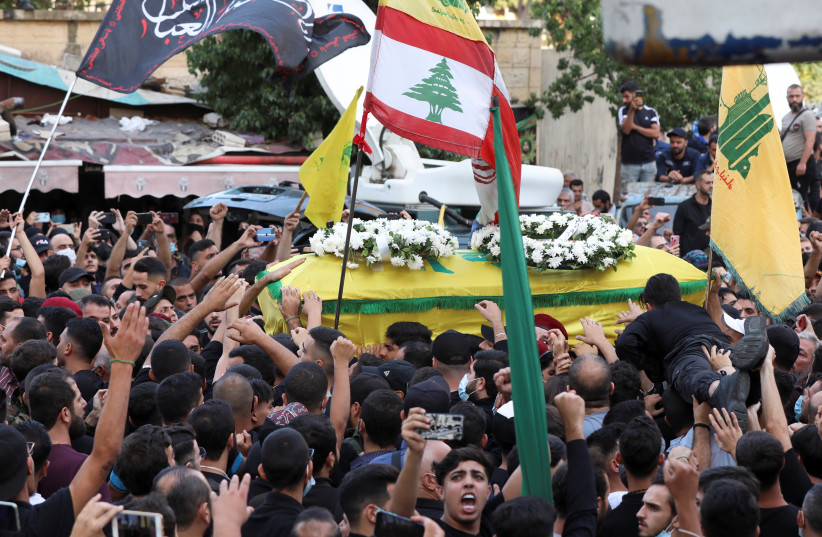Hezbollah bragged this week that it has 100,000 fighters. The figure is a major exaggeration, but it is symbolic of how Hezbollah no longer feels the need to even pretend to be a small “resistance” movement, but brags that it has more forces than the Lebanese army and has in effect made Lebanon a colony within the greater Hezbollah empire.
Expert on Lebanon Hanin Ghaddar, who is at the Washington Institute for Near East Policy, wrote that Hezbollah leader Hassan Nasrallah had given the 100,000 figure. She noted on Twitter that it was an exaggeration, “even if you include the reservists. In addition, quantity is one thing, but quality of their fighters has been shaken by long wars, budget shifts and emergency recruiting during Syria [conflict]...”
Nasrallah’s exaggeration was meant to preempt talk of a “civil war” after Hezbollah members claimed they were shot at during a recent protest in which the terrorist group was trying to topple a judge investigating a massive explosion in Beirut that was likely caused by Hezbollah’s ammonium nitrate. It has pointed fingers at Christian leader Samir Geagea and his Lebanese Forces, telling them not to miscalculate.
The context here is important. Back in the 1970s, a Lebanese civil war broke out. It pitted Christian militias against Muslim and Druze ones, as well as Palestinian groups. At the time, there was no Hezbollah, but there were Shi’ite militias and the Amal movement. The Shi’ites were a marginalized small minority group, however. Christians and Sunni Muslims dominated Lebanon.
After Israel’s invasion in 1982 and the Palestinian terror groups leaving Lebanon, the country’s civil war sputtered on. The Syrians had also invaded the country in the 1970s; an accord brokered by Saudi Arabia in 1989 eventually helped end the war.

The result was that the official power of Christians was slightly reduced, a power cemented through demographics and the parliament election system that guaranteed Christians power in the presidency. A weakened presidency led to a stronger Sunni Muslim prime minister. The Shi’ites got the position of parliament speaker.
Hezbollah doesn’t derive its power, however, from the superannuated speaker of parliament Nabih Berri, who has held his position since 1992. Instead it has its power due because after the Sunni, Christian and Druze militias put down their weapons in the wake of the 1989 agreement, Hezbollah kept its weapons, claiming to be “resisting Israel.”
WHEN ISRAEL left Lebanon in 2000, Hezbollah kept its vastly expanded arsenal, claiming that because the Jewish state held a few dunams on a mountain at the border, it needed to get this small area back. What really happened is that Hezbollah plotted its path to control Lebanon. It assassinated the former Sunni prime minister, Rafic Hariri, in 2005.
When protests caused Syria to leave the country in the wake of the murder, Hezbollah plotted to attack Israel with direct support from Iran and its henchman Qasem Soleimani. Soleimani, Nasrallah and Imad Mughniyeh plotted and a war broke out in 2006. When that was over, Hezbollah used the destruction it wrought to increase power over construction, housing and its own phone and telecommunications network. When the parliament tried to take away the telecommunications network, Hezbollah invaded areas in Beirut in 2008 and showed off its new muscles.
Soon, it was keeping a new president from being appointed, forcing Christians to make a choice: Lose their remaining power, or ally with the Islamist group. Michael Aoun chose to work with Hezbollah and got the presidency. Other Christians like Samir Geagea did not agree and neither did Sunnis like Saad Hariri.
Hezbollah systematically assassinated rivals, and intellectuals like Lokman Slim. It also sent fighters to Syria during the civil war and expanded its arsenal from 13,000 rockets to 150,000 rockets, missiles and drones. It also sent forces to the Golan to prepare for expanding the war against Israel.
All this is a long way of saying that Hezbollah’s real power is now through strangling parliament and the presidency and running Lebanon’s foreign and military policy. Now it even imports gas.
But it doesn’t have 100,000 fighters. That is because the overall Shi’ite community Hezbollah draws on for support is divided, with many backing Hezbollah ally Amal. To have 100,000 fighters you would need several million Shi’ite Hezbollah backers. Where are those people? Where are the trained fighters? How would you feed all those men?
The fact is that even though Hezbollah is a powerful terror army, has precision guided weapons, drones, bunkers and its own communications network – and runs drugs all over the world, stockpiles ammonium nitrate, destroys cities, bankrupts Lebanon and robs it of its future – its 100,000 figure is just in Nasrallah’s imagination.
